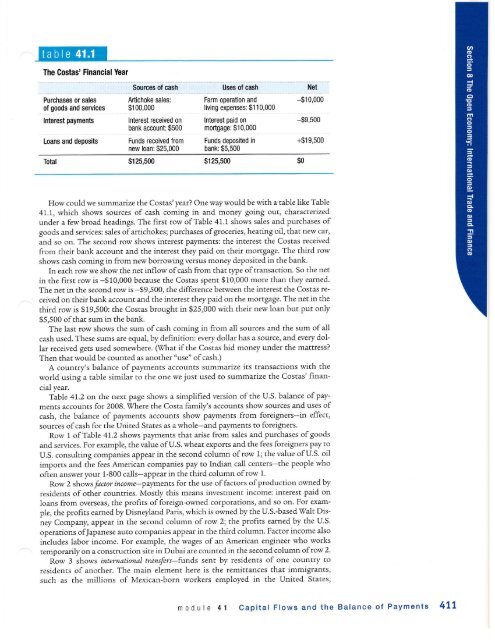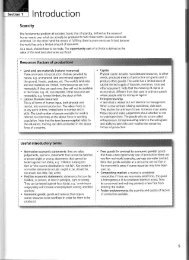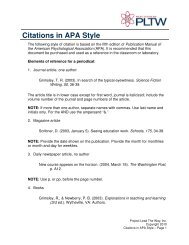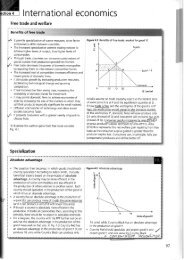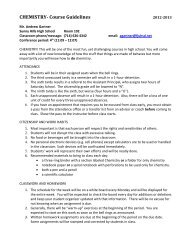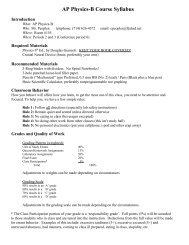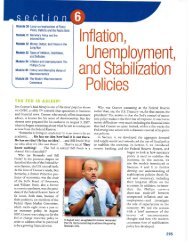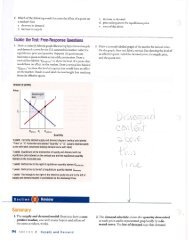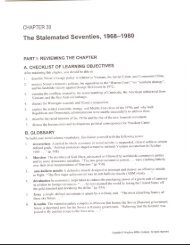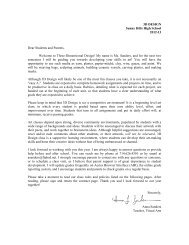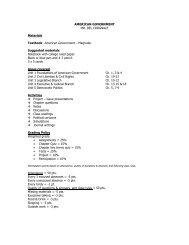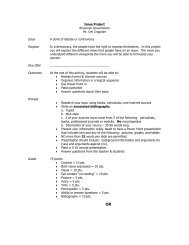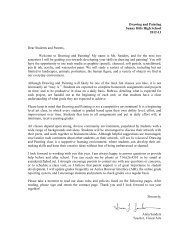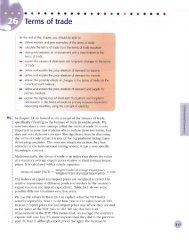AP Econ Module 41 Capital Flows Balance Payments - Sunny Hills ...
AP Econ Module 41 Capital Flows Balance Payments - Sunny Hills ...
AP Econ Module 41 Capital Flows Balance Payments - Sunny Hills ...
You also want an ePaper? Increase the reach of your titles
YUMPU automatically turns print PDFs into web optimized ePapers that Google loves.
EETililI<br />
The Costas' Financial Year<br />
Purchases or sales<br />
of goods and services<br />
lntorest payments<br />
Loans and deposib<br />
Sources of cash t ses of cash Net<br />
Artichoke sales:<br />
$100,000<br />
lnterest received on<br />
bank account $500<br />
Funds received from<br />
new loan:$25,000<br />
Farm operation and<br />
livinq expens€s: $1 10,000<br />
lnterest paid on<br />
mortgage:$10,000<br />
Funds deposited in<br />
bank $5,500<br />
Total $125,500 $125,500<br />
-$10,000<br />
-$9,500<br />
+$19,500<br />
How could we summarize the Costas' yeat? One way would be with a table like Table<br />
<strong>41</strong>.1, which shows sources of cash coming in and money going out, characterized<br />
under a few broad headings. The first row ofTable <strong>41</strong>.1 shows sales and purchases of<br />
goods and services: sales ofartichokes; purchases ofgroceries, heating oil, that new car,<br />
ald so on. The second row shows interest payments; the interest the Costas received<br />
from their bank account and the inter€st they paid on their mortgage. The third row<br />
shows cash coming in from new borrowing versus money deposited in the balt.<br />
In each row we show the net inflow ofcash from that rype oftransaction. So the net<br />
in the first row is -$10,000 because the Costas sPent $10,000 more than they earned'<br />
The net in the second row is -$9,500, the difference between the interest che Costas received<br />
on their bank account and the interesr they Paid on the mortgage. The net in the<br />
third row is $19,500: the Costas brought in $25,000 udth their new loan but put only<br />
$5,500 ofthat sum in the bank.<br />
The last row shows the sum of cash coming in from all sources and the sum of all<br />
cash used. These sums are equal, by definition: every dollar has a soutce, and every dollar<br />
received gets used somewhere. (What if the Costas hid money under the mattress?<br />
Then that would be counted as another "use" ofcash.)<br />
A country's balance of palT nents accounts summarize its cransactions with the<br />
world using a table similar to the one we just used to summarize the Costas' financial<br />
year.<br />
'fable 4I.2 on the next page shows a simplified version of the U.S. balance of paymenrs<br />
accounts for 2008. 'rX4rere rhe Costa family's accounts show sources and uses of<br />
cash, the balalce of payments accounts show <strong>Payments</strong> from foreigners-in effect,<br />
sources ofcash for the United States as a whole-and payments to foreigners.<br />
Row 1 of Table <strong>41</strong>.2 shows payrnents that arise from sales and purchases ofgoods<br />
and services. For example, the value of U.S. wheat exports and the fees foreigners Pay to<br />
U.S. consulting companies appear in the second column ofrow 1; the value of U.S. oil<br />
imports and the fees American companies pay to Indian call centers-the people who<br />
often answer your 1-800 calls-appear in the third column ofrow 1.<br />
Row 2 showspcfor income-peyrtents for the use offactors ofproduction owned by<br />
residents of other countries. Mostly this means investment income: interest paid on<br />
loans from overseas, the profits of foreign-owned corporations, and so on. For example,<br />
the profits eamed by Disneyland Paris, which is owned by the U.S.-based Walt Disney<br />
Company, appear in the second column of row 2; the profits earned by the U.S.<br />
operations ofJapanese auto comPanies appear in the third column. Factor incorne also<br />
includes labor income. For example, the wages of an American engineer who works<br />
temporarily on a construction site in Dubai are counted in the second column ofrow 2.<br />
Row 3 shows internationdl transfers-funds sent by residents of one counrry to<br />
residents of another, The main element here is the remittances that immigrants,<br />
such as the millions of Mexican-born workers employed in the United Scates,<br />
$o<br />
m 0 d u le 4 l capital <strong>Flows</strong> and the <strong>Balance</strong> of <strong>Payments</strong> 477


